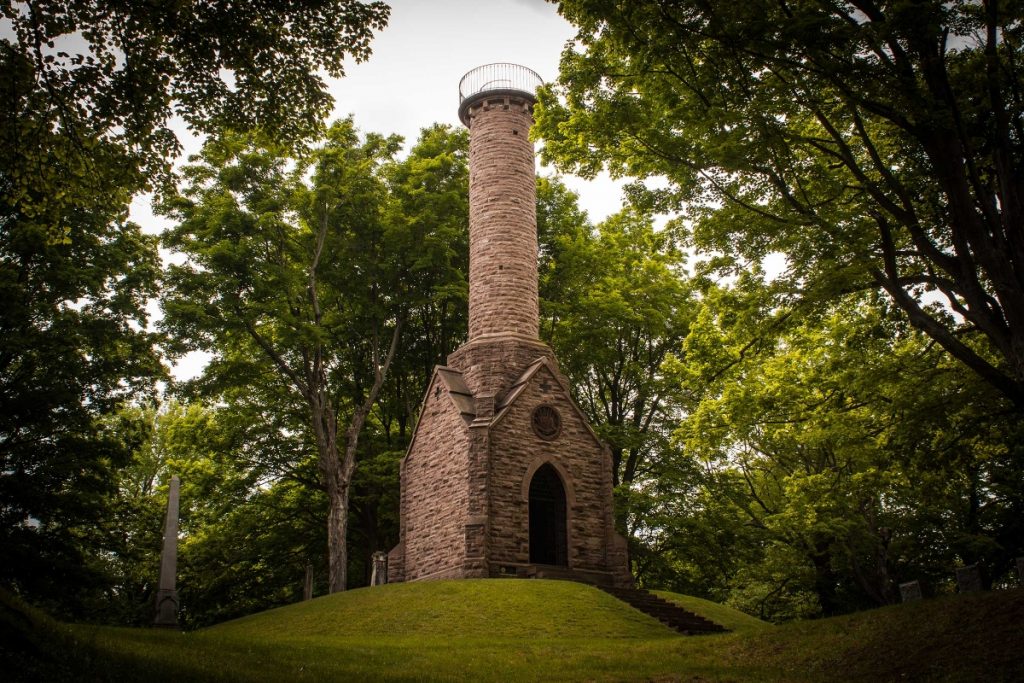Volume 4, Issue 21
Passing through the sandstone arch of Mount Albion Cemetery, one may catch a glimpse of the towering monument atop the highest point in the area. The Soldiers & Sailors Monument is perhaps the most impressive and beautiful war memorials in our area, but the true significance of the shrine is often overshadowed by the novelty and “thrill of the climb” up the winding steel staircase. There is a commonality between the circumstances surrounding the efforts to erect this monument to the memory of over 450 men who lost their lives during the Civil War and the war itself. In the face of grave sacrifice, a community struggled to memorialize the hundreds of young men, sons, brothers, and fathers, who left the security of home for ideals far greater than themselves.
Efforts to construct a county-wide memorial were initiated in 1864, but the association struggled to raise the necessary funds to complete the project. In 1868, the Orleans County Monument Association was established with Ezra T. Coann, H. J. Van Dusen, E. K. Hart, Joseph Cornell, Calvin Beach, John N. Proctor, Charles A. Harrington, John Hull White, Walker Mattison, Seth Spencer, Henry A. King, and Hiram Sickels as directors. Fundraising was slow, but the group was persistent in their labors. By 1874, the organization had raised $3,000 and construction began soon after with an additional $2,000 from the Cemetery Association. On July 4, 1876, as the nation celebrated its centennial, Orleans County dedicated the newly completed Soldiers & Sailors Monument.
“The Tower” remained a permanent fixture on Albion’s horizon and over the years became a destination for local youth, with varying intentions, who trekked to the top. Time chipped away at the monument and by the 1970s was in significant need of tender care and attention. The Orleans County Historical Monument Corporation, with involvement from notable local residents including C. W. Lattin, Harold Breuilly, and Donna Rodden, shouldered the burden of raising the necessary funds to restore the local landmark. With over $20,000 raised, the tower was repaired and rededicated on July 4, 1976; the centennial of the monument and bicentennial of the nation.
On two separate occasions, the community labored tirelessly to preserve the memory of local soldiers. Although erected to memorialize those who sacrificed their lives during the Civil War, perhaps the tower is more a monument to the perseverance of a community; a community that values the preservation and understanding of the past. With a monument that is 142 years old and a cemetery celebrating 175 years, we are fortunate to have such breathtaking landmarks scattered throughout our area.
It may be fitting to share a few brief notes of interest pertaining to Civil War veterans from Orleans County. Thousands of men would enter into service with the Union Army, some would never return, yet many would return with permanent physical and mental scars from the horrors of battle.
Jennie Curtis of Albion traveled to Washington, D.C. following the Battle of Bull Run to care for her brother who was reported as seriously wounded. On one occasion, she dared to venture out on horseback to determine the location of Confederate lines when she was taken prisoner and accused of being a spy. She was eventually released and spent time caring for sick and wounded soldiers.
Lt. Col. Rufus B. Bullock of Albion traveled south to Augusta, Georgia to work with the Southern Express Company. At the outbreak of the Civil War, he accepted a commission as lieutenant colonel with the responsibility of overseeing telegraph, railroad, and freight interests in Georgia. At the conclusion of the war, he was elected as governor of Georgia in 1868.
Maj. Thomas Bell, 8th N.Y. Cavalry – developing a fondness early on in life for theater, Bell allegedly spent two years with Edwin Booth’s company in Alabama before engaging in the foundry business at Albion. After the war, he introduced an article into U.S. law giving veterans preference in civil service appointments.
Pvt. Otis McOmber, 76th N.Y. Infantry – Carlton native enlisted in 1863 and was mustered into service with the “Cortland Regiment.” At the Battle of the Wilderness, his unit was surrounded by Confederates and taken prisoner. He spent over 11 months at Andersonville Prison where he survived by bribing Confederate soldiers with money sewn into the breast pocket of his coat. His brother Charles was killed at Fredericksburg and brother Lorenzo died during service with the 17th N.Y. Light Independent Artillery.
Pvt. Herbert Taylor, 140th N.Y. Infantry – Clarendon native Herbert Taylor was with his regiment at Gettysburg on July 2, 1863 and repulsed the attack on Little Round Top. Making the ultimate sacrifice, he is believed to be the only Orleans County native to have died at Gettysburg.
Pvt. Isaac Hawkins, 54th Massachusetts Infantry – Medina resident Isaac Hawkins enlisted with the all African-American regiment once headed by Col. Robert Gould Shaw and made famous by the 1989 film “Glory.” Hawkins was captured at the Battle of Olustee in Florida, spending over a year at Andersonville Prison Camp and on one such occasion allegedly received 250 lashes as punishment for an unknown reason.
Maj. Angelo Paldi, 1st Michigan Cavalry – a native of Italy, Paldi was a respected painter and solider who allegedly served with the French Army in Algeria and Spain before immigrating to America. Serving under Gen. George Custer for a short period of time, it was Paldi’s suggestion to form a regiment of Hussars, or heavy cavalry, modeled after the regiments of Europe. After the war he moved to Albion, his body is interred at St. Joseph’s Cemetery in Albion.


